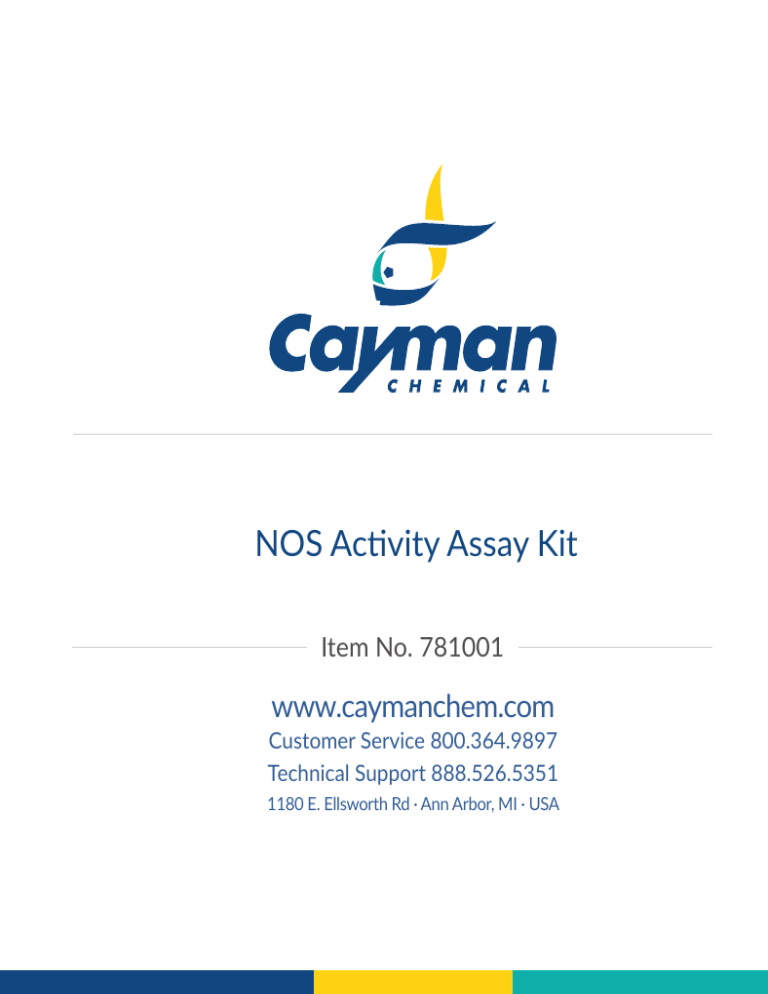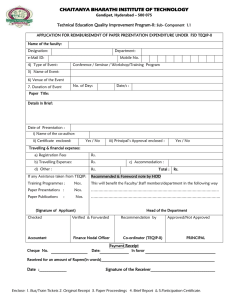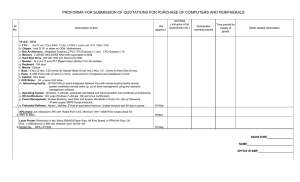
NOS Activity Assay Kit
Item No. 781001
www.caymanchem.com
Customer Service 800.364.9897
Technical Support 888.526.5351
1180 E. Ellsworth Rd · Ann Arbor, MI · USA
TABLE OF CONTENTS
GENERAL INFORMATION
3 Materials Supplied
4 Safety Data
4Precautions
4 If You Have Problems
5 Storage and Stability
PRE-ASSAY PREPARATION
ASSAY PROTOCOL
Quantity
Storage
10007068
iNOS Positive Control
50 μl
-80°C
10007061
Calmodulin (1 μM)
200 μl
-20°C
10007062
Reaction Buffer (2X)
1.25 ml
-20°C
10007067
L-NNA (10 mM)
100 μl
-20°C
10007063
Homogenization Buffer (10X)
50 ml
RT
10007064
Stop Buffer
25 ml
RT
10007065
Equilibrated Resin
5 ml
RT
16Appendix
10007066
Calcium Chloride (6 mM)
400 μl
RT
17 Quick Reference Protocol
10007069
Spin cups and cup holders
50
RT
6 About This Assay
8 Sample Preparation
12 Performing the Assay
13 Preparing the Reactions
ANALYSIS
15Calculations
RESOURCES
Kit will arrive packaged as a -80°C kit. For best results, remove components and
store as stated below.
Item
10 Reagent Preparation
Materials Supplied
Item Number
5 Materials Needed but Not Supplied
INTRODUCTION
GENERAL INFORMATION
18References
19Notes
19 Warranty and Limitation of Remedy
If any of the items listed above are damaged or missing, please contact our
Customer Service department at (800) 364-9897 or (734) 971-3335. We cannot
accept any returns without prior authorization.
!
WARNING: THIS PRODUCT IS FOR RESEARCH ONLY - NOT FOR
HUMAN OR VETERINARY DIAGNOSTIC OR THERAPEUTIC USE.
GENERAL INFORMATION
3
Safety Data
Storage and Stability
This material should be considered hazardous until further information becomes
available. Do not ingest, inhale, get in eyes, on skin, or on clothing. Wash
thoroughly after handling. Before use, the user must review the complete Safety
Data Sheet, which has been sent via email to your institution.
This kit will perform as specified if stored as listed in the Materials Supplied (see
page 3) and used before the expiration date indicated on the outside of the box.
Precautions
Please read these instructions carefully before beginning this assay.
1.[3H]Arginine monohydrochloride [40-70 Ci/mmol, 1 μCi/μl (Perkin Elmer,
Item No. NET1123001MC)] -or- [14C]arginine [>300 mCi/mmol, 100 μCi/ml
(Perkin Elmer, Item No. NEC267E050UC)]
If You Have Problems
2. Reduced nicotinamide adenine dinucleotide phosphate (NADPH*) (Sigma,
Item No. N1630 or N7505)
Technical Service Contact Information
3. 10 mM Tris-HCl, pH 7.4
Phone:
888-526-5351 (USA and Canada only) or 734-975-3888
Fax:
734-971-3641
Email:techserv@caymanchem.com
Hours:
M-F 8:00 AM to 5:30 PM EST
In order for our staff to assist you quickly and efficiently, please be ready to supply
the lot number of the kit (found on the outside of the box).
4
GENERAL INFORMATION
Materials Needed But Not Supplied
4. Optional: Magnesium acetate (Sigma, Item No. M2545) for assaying crude
iNOS samples (see page 12)
5. Scintillation fluid and vials
6. A source of pure water; glass distilled water or HPLC-grade water is
acceptable
*NADPH is not stable in solution; therefore, it is not included in the Reaction
Buffer.
GENERAL INFORMATION
5
INTRODUCTION
About this Assay
Measuring NOS activity by monitoring the conversion of arginine to citrulline is
a standard assay for NOS activity in both crude and purified enzyme preparation.
Advantages of the NOS Activity Assay Kit include the use of radioactive
substrates ([3H]arginine or [14C]arginine) that enable sensitivity to the picomole
level, as well as the specificity of the assay for the NOS pathway due to the direct
enzymatic conversion of arginine to citrulline in eukaryotic cells. Additionally, the
easy separation of neutrally charged citrulline from positively charged arginine
allows multiple assays to be performed easily.
OH
H2N
H2N
NH2+
NH
H2N
N
NH
NH
NADPH
O2
H3N+
COO-
L-Arginine
O
Cayman’s NOS Activity Assay Kit is a simple, sensitive and specific assay for
nitric oxide synthase (NOS) activity. The NOS Activity Assay Kit is based on the
biochemical conversion of L-arginine to L-citrulline by NOS.1-6 This reaction,
which represents a novel enzymatic process, involves a five-electron oxidation
of a guanidino nitrogen of L-arginine to nitric oxide (NO), together with the
stoichiometric production of L-citrulline (see Figure 1, on page 7). The reaction
consumes 1.5 equivalents of reduced nicotinamide adenine dinucleotide
phosphate (NADPH) and also requires molecular oxygen, calcium, calmodulin,
and tetrahydrobiopterin (BH4).7,8
For routine assays, radioactive arginine is added to protein extracts or purified
NOS samples. After incubation, the reactions are stopped with a buffer
containing ethylenediaminetetraacetic acid (EDTA), which chelates the calcium
required by nNOS (neuronal NOS; NOS I) and eNOS (endothelial NOS; NOS III)
and, consequently, inactivates the enzyme. In the case of iNOS (inducible NOS;
NOS II), the low pH of the Stop Buffer, pH 5.5, stops the enzyme-catalyzed
reaction. Equilibrated Resin, which binds to the arginine, is added to the sample
reactions and the reactions are then pipetted into spin cups. The citrulline, being
ionically neutral at pH 5.5, flows through the cups completely. NOS activity is
then quantitated by counting the radioactivity in the eluate.
1/2 NADPH
O2
H2O
H3N+
COO-
L-Hydroxyarginine
+ NO
H2O
H3N+
COO-
L-Citrulline
Figure 1. NOS catalyzes a 5-electron oxidation of a guanidino nitrogen of
L-arginine to generate NO and L-citrulline. L-Hydroxyarginine is formed as an
intermediate that is tightly bound to the enzyme. Both steps in the reaction are
dependent on calcium and calmodulin.
6
INTRODUCTION
INTRODUCTION
7
PRE-ASSAY PREPARATION
Sample Preparation
Preparation of Extracts from Tissues and Cultured Cells
The citrulline assay has been used to quantitate levels of NOS activity in tissue
homogenates from numerous sources including blood vessels, immune cells,
visceral organs, nervous tissue, and cultured cells. NOS enzymes are relatively
unstable; therefore, tissues should be harvested quickly after animal euthanasia.
If enzyme assays are to be conducted at a later time, it is best to freeze intact
tissues or harvested cultured cells prior to homogenization. Wrap the tissues in
aluminum foil, flash freeze the tissues in liquid nitrogen, and then store at -80°C.
Extraction of Proteins from Tissues
NOTE: Because the level of NOS activity will vary between tissues, the volume of 1X
Homogenization Buffer used may require optimization.
Subcellular Tissue Distribution
The subcellular distribution of NOS is tightly regulated in tissues. eNOS is largely
membrane associated as a result of N-terminal myristoylation.9,10 nNOS is largely
soluble in adult rat brain, yet in skeletal muscle, it is predominantly associated
with membrane fractions.11 The mechanism for membrane attachment of nNOS
remains unclear. iNOS is a soluble enzyme. NOS activity in soluble and membraneassociated fractions can be separated by centrifuging the homogenized tissues
at 100,000 x g for 60 minutes. The supernatant contains soluble NOS, while the
pellet, which is resuspended in Homogenization Buffer, contains membraneassociated NOS.
Extraction of Proteins from Tissue Culture Cells
Certain cultured cells, such as endothelial cells and activated macrophages,
contain NOS, which can be measured using the citrulline assay. The proteins
must first be extracted from the cells as follows:
1. Remove the culture media from the tissue culture cells.
1. Prepare an appropriate volume of Homogenization Buffer (1X) (i.e., a
1:10 dilution of the Homogenization Buffer (10X) (Item No. 10007063).
Add 10-20 volumes [volume of buffer (ml):weight of tissue (g)] of ice-cold
Homogenization Buffer (1X)to a tissue sample (for tissues with low NOS
activity, start with 5-10 volumes of Homogenization Buffer (1X)).
2. Wash the tissue culture cells once with phosphate-buffered saline (PBS) and
harvest the tissue culture cells in PBS containing 1 mM EDTA. Transfer the
tissue culture cells to microcentrifuge tubes.
2. Homogenize the tissue using a tissue grinder or an equivalent tissue
homogenizer. Keep the tissue homogenate on ice.
4. Remove the supernatant from the pelleted cells by vacuum aspiration
and then add 100-500 μl of the Homogenization Buffer (1X) to each
microcentrifuge tube of pelleted cells. Sonicate briefly to disrupt the cells.
3. Centrifuge at 10,000 x g for 15 minutes at 4˚C (or at full speed for five
minutes in a microcentrifuge at 4°C).
4. Transfer the supernatant to fresh microcentrifuge tubes and keep the tubes
on ice until use. This extract will be used in the NOS Activity Assay (see step
3 of Preparing the Reactions, page 13).
8
PRE-ASSAY PREPARATION
3. Spin the microcentrifuge tubes in a microcentrifuge at full speed for two
minutes to pellet the cells.
5. Spin the microcentrifuge tubes in a microcentrifuge at full speed for five
minutes.
6. Separate the supernatant from the pellet and adjust the resulting protein
sample to a concentration of 5-10 mg/ml.
PRE-ASSAY PREPARATION
9
Reagent Preparation
1. iNOS Positive Control - (Item No. 10007068)
The vial contains 50 µl of murine recombinant iNOS. Thaw the enzyme on
ice before use. It is then ready to use as a control in the assay.
2. Calmodulin (1 µM) - (Item No. 10007061)
The vial contains 1 µM calmodulin. It is ready to use in the assay.
3. Reaction Buffer (2X) - (Item No. 10007062)
The vial contains 1.25 ml of 50 mM Tris-HCl, pH 7.4, containing 6 μM
tetrahydrobiopterin (BH4), 2 μM flavin adenine dinucleotide, and 2 μM
flavin adenine mononucleotide.
4. Homogenization Buffer (10X) - (Item No. 10007063)
6. Stop Buffer - (Item No. 10007064)
The vial contains 25 ml of 50 mM N-2-hydroxyethylpiperazine-N´-2ethanesulfonic acid (HEPES), pH 5.5, and 5 mM EDTA. It is ready to use in
the assay.
7. Equilibrated Resin - (Item No. 10007065)
The vial contains 5 ml of resin. It is ready to use.
8. Calcium Chloride (6 mM) - (Item No. 10007066)
The vial contains 400 µl of 6 mM calcium chloride. It is ready to use to assay
nNOS and eNOS.
9. Spin Cups and Cup Holders - (Item No. 10007069)
Sufficient spin cups and cup holders are provided for 50 total reactions.
The vial contains 50 ml of 250 mM Tris-HCl, pH 7.4, containing
10 mM EDTA and 10 mM ethyleneglycol-bis(β-aminoethylether)-N,N,N´,N´tetraacetic acid (EGTA). See under Sample Preparation to determine how
much Homogenization Buffer (1X) to make.
5. L-NNA (10 mM) - (Item No. 10007067)
The vial contains 100 µl of 10 mM L-NNA. L-NNA is a non-specific NOS
inhibitor. It will eliminate all of the NOS activity. It is ready to use in the
assay.
10
PRE-ASSAY PREPARATION
PRE-ASSAY PREPARATION
11
ASSAY PROTOCOL
Performing the Assay
Measurement of Nitric Oxide Synthase Activity in Enzyme Extracts
NOTE: Refer to Appendix (on page 16) for notes on the stability of radiolabeled
arginine.
Incubation of the citrulline assay reaction may be carried out for 10-60 minutes
at 22-37°C depending on the tissue being used. High levels of nNOS in nervous
tissues12 and skeletal muscle11 permit brief assays (10-15 minutes) of NOS
with room temperature incubations. Lower levels of eNOS in vascular tissues
require that assays be performed for prolonged periods (60 minutes) at room
temperature.
eNOS and nNOS require calcium for enzyme activity; therefore, it is essential to
add calcium to experimental assays. A final free calcium concentration of 75 μM
is required for optimal NOS activity.12 When testing NOS activity from tissue
extracts, addition of calmodulin to the reaction is not required. However, when
testing purified NOS, the addition of calmodulin is required for nNOS and eNOS
(for review, see Reference 1, page 18). Crude extracts of macrophage iNOS, such
as the 100,000 x g supernatant solution, require 1 mM of Mg2+ for maximum
activity, while purified iNOS shows no such dependence.
NOS activity in the citrulline assay is defined as counts per minute (cpm) in
an incubated test sample as compared to an appropriate blank. The following
control reactions can serve as a blank: a reaction that includes 1 mM NG-nitroL-arginine (L-NNA, a competitive NOS inhibitor provided at a concentration of
10 mM), a reaction in which the extract is boiled prior to the assay, a reaction in
which either NADPH or calcium (for nNOS and eNOS) is omitted, or a reaction
that is incubated on ice. As for any quantitative enzyme assay, it is important to
verify reaction conditions are such that the assay is linear with respect to time
and protein concentration. Specific activity and substrate affinity of NOS can be
assessed by carrying out replicate reactions in the presence of varying amounts
of unlabeled arginine. The Km (Michaelis constant) of NOS is in the range of
2-20 μM.7,10,13 Appropriate concentrations of arginine for kinetic studies are
0.1-100 μM.
12
ASSAY PROTOCOL
Preparing the Reactions
1. Prepare and store the Reaction Mixture on ice by adding the following
components to a microcentrifuge tube (500 µl or 1.5 ml):
NOTE: The volumes given here yield sufficient Reaction Mixture for 10 reactions.
The Reaction Mixture can be stored on ice for up to 24 hours. Inducible NOS
(iNOS) is Ca2+ independent. When assaying iNOS, substitute 50 µl HPLC-grade
water for CaCl2 or add 50 µl of 8 mM MgCl2 (see page 12).
250 µl of Reaction Buffer (2X)
50 µl of 10 mM NADPH (freshly prepared in 10 mM Tris-HCl, pH 7.4)
10 µl of [3H]arginine (1 µCi/µl) -or- 5 µl [14C]arginine (100 µCi/ml)
50 µl of CaCl2 -or- 50 µl of HPLC-grade water -or- 50 µl MgCl2
40 µl of HPLC-grade water for [3H]arginine -or- 45 µl of HPLC-grade water
for [14C]arginine
2. Label 1.5 ml microcentrifuge tubes for the appropriate reactions below.
3. iNOS Positive Control - add 40 µl of Reaction Mixture, 5 µl of HPLC-grade
water, and 5 µl of iNOS Positive Control to a microcentrifuge tube.
4. Control Sample - add 40 µl of Reaction Mixture, 5 µl of calmodulin*, and
5 µl of tissue extract or NOS enzyme preparation to a microcentrifuge tube.
5. Inhibition of Control Sample (optional) - To chemically inhibit all of the NOS
activity in the control sample (background), add 5 µl of L-NNA to 40 µl of
Reaction Mixture before adding the 5 µl of tissue extract or NOS enzyme
preparation to a microcentrifuge tube. If needed, add 5 µl of calmodulin* to
the mixture.
ASSAY PROTOCOL
13
6. Incubate the reactions at 22-37°C for 10-60 minutes. (For initial experiments,
the reaction should be allowed to proceed at room temperature for
30 minutes.)
7. Stop the reactions by adding 400 µl of Stop Buffer to each microcentrifuge
tube.
*nNOS and eNOS require 0.1 µM calmodulin when assayed as purified
enzymes. The addition of calmodulin to tissue extracts is not necessary, but it is
recommended. If the addition of calmodulin is required, add calmodulin to a final
concentration of 0.1 µM (i.e., add 5 µl to a 50 µl reaction).
Processing the Samples
1. Thoroughly resuspend the Equilibrated Resin provided. Pipette 100 µl of the
Equilibrated Resin into each reaction sample.
2. Place the spin cups into cup holders and transfer the reaction samples to
spin cups.
3. Centrifuge the spin cups and holders in a microcentrifuge at full speed for
30 seconds.
ANAYLSIS
Calculations
The percent citrulline formed in the reaction in relation to total possible counts
can be determined as follows:
% Conversion = [(cpm reaction - cpm background*)/cpm total] x 100
*The cpm from the “blank” as described on page 12 can also be used here.
In the tissues assayed according to these protocols, citrulline is the major
radiolabeled compound in the eluate. This can be readily verified using
thin-layer chromatography (TLC). Separation of arginine and relevant metabolites is
achieved using silica-gel chromatography plates developed with CH3OH:NH4OH
(6:1). With this solvent system, arginine migrates at an Rf (the ratio of the distance
traveled by a compound to the distance traveled by the solvent) of ~0.1 while
citrulline migrates at an Rf of ~0.5.
4. Remove the spin cups from the cup holders and transfer the eluate (i.e., the
“flowthrough”) to scintillation vials. Add scintillation fluid to the vials and
quantitate the radioactivity in a liquid scintillation counter.
Additional Controls
1. Total Counts
To determine total counts used in the reaction, transfer 40 μl of the Reaction
Mixture to a scintillation vial. Add 400 μl of Stop Buffer. Add scintillation
fluid and quantify the radioactivity.
2. Background Counts
To determine background counts used in the reaction, transfer 40 μl of the
Reaction Mixture to a microcentrifuge tube. Add 400 μl of Stop Buffer and
100 μl of Euilibrated Resin. Process the Control the same as described for
the samples (i.e., apply to spin cups and count the eluate).
14
ASSAY PROTOCOL
ANALYSIS
15
RESOURCES
Quick Reference Protocol
Appendix
Preparation of Extracts from Tissues and Cultured Cells
Stability of Radiolabeled Arginine
•
Add 10-20 volumes of ice-cold Homogenization Buffer (1X) to a tissue
sample.
•
Homogenize the tissue and spin the homogenate in a microcentrifuge for
five minutes at 4°C (or 10,000 x g for 15 minutes at 4°C).
•
Transfer the supernatant to a fresh tube and keep the tube on ice until use.
Prior to initiating the enzyme assays, it is essential to verify the purity of the
radiolabeled arginine, otherwise a high blank value for the liquid scintillation
counting will greatly reduce the sensitivity of the assay. To assess the blank value,
a Reaction Mixture is applied to the Equilibrated Resin. Nonadherent radioactivity
is eluted with Stop Buffer, the eluate is collected and the radioactivity is
quantitated in a liquid scintillation counter.
1. Prepare a reaction mix by combining the following components in a
microcentrifuge tube.
20 μl of Reaction Buffer (2X)
Extraction of Proteins from Tissues
Extraction of Proteins from Tissue Culture Cells
•
Remove the culture media from the tissue culture cells, wash the cells with
PBS and harvest the cells in PBS containing 1 mM EDTA.
4 μl of 10 mM NADPH [freshly prepared in 10 mM Tris, pH 7.4]
• Spin the cells at full speed for two minutes, remove the supernatant by
vacuum aspiration and resuspend the cells in Homogenization Buffer.
1-10 μl of [3H]arginine (1 μCi/μl) or [14C]arginine (100 μCi/ml)
•
Sonicate or homogenize the cells.
dH2O to bring the total volume to 40 μl
•
Spin the cells at full speed in a microcentrifuge for five minutes at 4˚C,
remove the supernatant, and adjust the protein sample to a concentration
of 5-10 mg/ml.
2. Store the reaction mix on ice.
3. Perform the control experiments (i.e., total counts and background counts)
as described above using 10 μl of the Reaction Cocktail.
Greater than 90% of the applied radioactivity should be retained by the spin cup.
This represents a relatively low blank value. If more than 10% of the radioactivity
flows through the spin cup, it is important to purchase new arginine prior to
conducting the assay. [3H]Arginine is prone to radiolytic decay and may degrade
significatly within two months; [14C]arginine is more stable but more expensive.
Measurement of Nitric Oxide Synthase Activity in Enzyme Extracts
•
Prepare the Reaction Mixture in a microcentrifuge tube and store on ice.
•
Add the cell/tissue extract to 40 μl of the Reaction Mixture.
•
Incubate the reaction at 22-37°C for 10-60 minutes.
•
Add 400 μl of Stop Buffer and 100 μl of Equilibrated Resin to the reaction
sample.
• Transfer the reaction sample to a spin cup and spin at full speed for
30 seconds.
•
16
RESOURCES
Transfer the eluate to a scintillation vial, add scintillation fluid, and quantitate
the radioactivity in a liquid scintillation counter.
RESOURCES
17
References
NOTES
1. Bredt, D.S. and Snyder, S.H. Annu. Rev. Biochem. 63, 175-195 (1994).
2. Ignarro L.J. Biochem. Pharmacol. 41, 485-90 (1991).
3. Marletta, M.A. J. Biol. Chem. 268, 12231-12234 (1993).
4. Moncada, S. and Higgs, A. N. Engl. J. Med. 329, 2002-2012 (1993).
5. Nathan, C. and Xie, Q.W. J. Biol. Chem. 269, 13725-13728 (1994).
6. Schmidt, H.H., Lohmann, S.M., and Walter, U. Biochim. Biophys. Acta 1178,
153-175 (1993).
7. Stuehr, D.J., Cho, H.J., Kwon, N.S., et al. Proc. Natl. Acad. Sci. USA 88,
7773-7777 (1991).
8. Schmidt, H.H., Pollock, J.S., Nakane, M., et al. Proc. Natl. Acad. Sci. USA 88,
365-369 (1991).
9. Busconi, L. and Michel, T. J. Biol. Chem. 268, 8410-8413 (1993).
10. Pollock, J.S., Forstermann, U., Mitchell, J.A., et al. Proc. Natl. Acad. Sci. USA
88, 10480-10484 (1991).
11. Kobzik, L., Reid, M.B., Bredt, D.S., et al. Nature 372, 546-548 (1994).
12. Knowles, R.G., Palacios, M., Palmer, R.M., et al. Proc. Natl. Acad. Sci. USA 86,
5159-5162 (1989).
13. Bredt, D.S. and Snyder, S.H. Proc. Natl. Acad. Sci. USA 87, 682-685 (1990).
14. Salter, M., Knowles, R.G., and Moncada, S. FEBS Lett. 291, 145-149 (1991).
Warranty and Limitation of Remedy
Buyer agrees to purchase the material subject to Cayman’s Terms and Conditions.
Complete Terms and Conditions including Warranty and Limitation of Liability
information can be found on our website.
This document is copyrighted. All rights are reserved. This document may not, in
whole or part, be copied, photocopied, reproduced, translated, or reduced to any
electronic medium or machine-readable form without prior consent, in writing,
from Cayman Chemical Company.
©08/02/2016, Cayman Chemical Company, Ann Arbor, MI, All rights reserved.
Printed in U.S.A.
18
RESOURCES
RESOURCES
19



